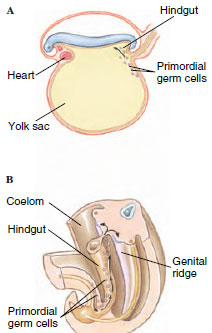Migration of Germ Cells
 |
| Figure 7-5 Migration of mammalian primordial germ cells. A, From the yolk sac the rimordial germ cells migrate through the region of the hindgut into the genital ridges (B). In human embryos, the migration is complete by the end of the fifth week of gestation. |
In vertebrates, the actual tissue from which gonads arise appears in early development as a pair of genital ridges, growing into the coelom from the dorsal coelomic lining on each side of the hind-gut near the anterior end of the kidney (mesonephros).
Surprisingly perhaps, the primordial germ cells do not arise in the developing gonad, but in the yolk-sac endoderm. From studies with frogs and toads, it has been possible to trace the germ cell line back to the fertilized egg, in which a localized area of germinal cytoplasm (called germ plasm) can be identified in the vegetal pole of the uncleaved egg mass. This material can be followed through subsequent cell divisions of the embryo until it becomes situated in primordial germ cells in gut endoderm. From here the cells migrate by ameboid movement to the genital ridges. A similar migration of primordial germ cells occurs in mammals (Figure 7-5). Primordial germ cells are the future stock of gametes for an animal. Once in the genital ridges and during subsequent gonadal development, germ cells begin to divide by mitosis, increasing their numbers from a few dozen to several thousand.




